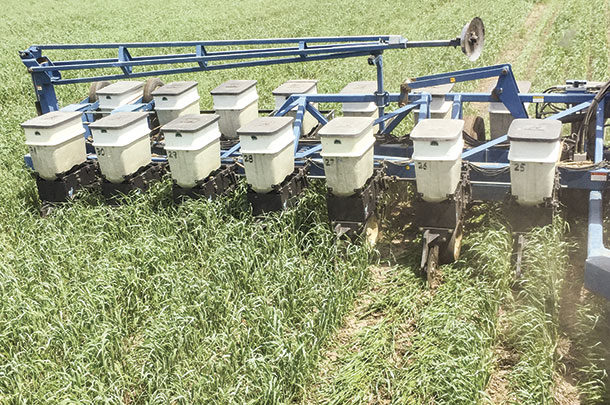Not only are you looking for ways to improve, but you’re looking for ways to do things faster. Believe it or not, planting rye can help you accomplish both of those goals.
Cody Nelson, president at Soil RX Inc., says, “Whenever you can add diversity to the cropping rotation and add livestock back to the soil, you can see very dramatic improvements.” As a professional in the cover crop industry, he works with many growers who not only plant cover crops but use those crops as an extra source of forage or as an added grazing area.
Let’s start with the benefits of planting rye. Nelson says a cover-crop grower will see many improvements from increased water-holding capacity, keeping the soil temps cooler throughout the heat of the summer and even help with white mold.
The benefits don’t end there. Matthew Boucher, a dealer for Potential Ag, says rye provides the potential for increased organic matter in the soil, soil erosion control, water infiltration, soil tilth and other soil health benefits. Many farmers across the country are using cover crops, especially rye, and seeing the benefits, he says.
Adam Nechanicky, a farmer from Buckingham, Iowa, says he plants rye for improved water infiltration, to scavenge and recycle nutrients, reduce soil erosion and to help suppress weeds. So far, he has seen these all play out in his fields, and he likes what he is seeing.
“I can get into the field sooner after a rain compared to the neighbors,” says Nechanicky. “I can walk in the field after an inch or more of rain and not get mud on my boots.”
He isn’t the only one who has seen these benefits for his fields. William Schreurs, a farmer from Alvord, Iowa, says he’s seen the same kind of results. On his farm, he has seen less soil erosion and water runoff, plus it’s helped tremendously with his weeds during the summer.
Now add the benefits of grazing cattle. As a grower and livestock producer, growing cover crops benefits grazing cattle as well as adding benefits to the soil. “Grazing rye offers the cattle a quality fresh, green nutrient-filled food source, offering 14 to 17 percent protein in most cases. Its full and lush plant stature helps ease the grazing stresses on the rest of the pasture mix that thrives at other times of the year,” Boucher says.
Schreurs, who grazes his cattle on his rye, has seen incredible outcomes. Since he grazes in the fall and spring, he gets two added bonuses. First, in the spring he turns out his cows and new calves into the rye. He says this has helped minimize the sickness with his newborns. Grazing in the fall allows his herd to graze longer into the year, creating less need for supplementation, and his cows stay in better condition longer into the winter.
Nelson’s list of benefits isn’t much different than Schreur’s. “Grazing a winter rye cover crop can bring a lot of benefits to a cattle operation.
One being the ability to get cows out grazing on an annual forage earlier than any perennial forage would be ready for grazing,” Nelson says. “In a lot of cases, this will get cows or pairs out of lots and fresh spring growth, increasing the efficiencies of the cow herd and dramatically helping with herd health issues. Calves born on rye cover are much healthier than calves being born in a mud or drylot.”
The benefits don’t stop with the herd. Nelson says the crops would see some major benefits to the livestock grazing. The roots of the cover crops are already helping the soil to breathe by not only cycling nutrients that were unavailable to the corn and beans through the rye, but when the rye is run through a cow, there are even more nutrients available. Nelson says, “There isn’t a better way to stimulate biological activity in a crop field than to add diversity in the crops planted but also adding the livestock out there.”

Maybe it isn’t feasible for some to graze rye, but it doesn’t have to be grazed to be beneficial to a herd. It also serves as a great source of forage that can either be baled or put into a silage bag. Nechanicky has baled and chopped rye. This year, he bagged the rye and was pleasantly surprised with the result. He ended up with more tonnage than he expected and had a lot more feed than he needed.
Nelson explains why there is such an influx in the nutrient value of rye. He says rye is an “it depends” kind of situation. Rye will be very high in protein when it is very short. It will then decrease in protein and increase in energy as it matures. He says if you’re planning on baling or chopping it, you do need to be aware of its maturity.
Once the rye reaches a certain point, and its carbon-to-nitrogen ratio is off too far, it will start to lose feed value quickly. Either way, rye can provide an excellent source of protein for a herd during the winter months and when in need of some good, quality forage.
When it comes to your land and cattle, planting rye can be beneficial in a multitude of ways, including soil erosion, healthier calves and weed suppression. Rye gives producers the ability to graze earlier and longer in the season or provide an excellent protein source for the herd.
With rangeland and forage becoming harder and harder to come by, it’s definitely worth looking into the benefits of rye. ![]()
PHOTO 1: Beans were planted directly into a cover-crop rye stand.
PHOTO 2: Rye doesn’t have to be grazed but can also be chopped and bagged for silage. Photos provided by Kellie Gregorich.
Kellie Gregorich is a freelance writer based in Oxford Junction, Iowa.











